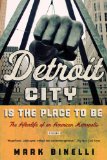Summary | Excerpt | Reviews | Beyond the Book | Readalikes | Genres & Themes | Author Bio

Critics' Opinion:
Readers' Opinion:
First Published:
Nov 2012, 336 pages
Paperback:
Nov 2013, 336 pages
 Book Reviewed by:
Book Reviewed by:
Poornima Apte
Buy This Book
Often, people incorrectly isolate the 1967 riot as the pivotal Detroit-gone-wrong moment, after which nothing ever went right. In fact, the auto industry had been in a serious economic slump for at least a decade prior, with tension in the black community festering for even longer and the axial shift of jobs and white residents from city proper to suburbs solidly under way. What the civic unrest, aside from hastening the process, did permanently change was the national story line about the city. If, once, Detroit had stood for the purest fulfillment of U.S. industry, it now represented America's most epic urban failure, the apotheosis of the new inner-city mayhem sweeping the nation like LSD and unflattering muttonchop sideburns. The fires of the rebellion launched a long-running narrative, one that persists today, of Detroit as a hopelessly failed state, a terrifying place of violent crime and general lawlessness. As John Lee Hooker, who had come north to work on the assembly line at Ford and later made his name as a bluesman in the juke joints of Detroit's Hastings Street, sang in "Motor City Is Burning":
My hometown burnin' down to the ground
Worser than Vietnam . . .
That, for as long as I can remember, might as well have been the unofficial slogan of the city. WELCOME TO DETROIT: WORSER THAN VIETNAM.
Things proceeded apace—that is to say, horribly—despite a brief lull of hope offered by the election, in 1974, of Coleman Young, the city's first black mayor. With the emergence of crack, drug violence bloodied the city, while Devil's Night, the night before Halloween, traditionally a time for relatively harmless pranks involving toilet-papered trees and soaped car windows, turned into an annual citywide arson festival, peaking in 1984 with an estimated eight hundred fires. As a media event, Devil's Night proved irresistibly photogenic, the smoke hanging over the city seeming to taunt its distant twin in 1967. Rather than two lit ends of a time line, the fires came to feel like a single conflagration, one that had never been extinguished, the time line itself—the entirety of the seventies—merely a long, slow-burning fuse.
Detroit has long been a city observers find endlessly fascinating, often to the irritation of people who actually live in Detroit—the kind of place easily conscripted for overblown metaphorical theses or described as being a "symptom" of something bigger. Whenever I told people I'd grown up in metropolitan Detroit, they expressed a morbid curiosity, as if I'd revealed having been raised the next town over from Chernobyl or in the same apartment building as Jeffrey Dahmer. Other urban centers face very similar problems, but none have plummeted from the same heights as Detroit. The story of the city, of its meteoric rise and stunning fall, possesses the sort of narrative arc to which people seem hardwired to respond. It's an almost classically structured tale of humble origins transcended by entrepreneurial moxie and much diligent toil, all eventually brought low by tragic flaws (hubris, greed, long-simmering prejudices come home to roost).
Of course, on a basic level of storytelling, people also love tales of Detroit because there's just something inherently pleasing about having one's plot expectations so consistently fulfilled. When the chief of police takes to Facebook to warn Christmas shoppers in Detroit not to carry cash (because of the high probability of being mugged) or when, over the course of a single fiery afternoon, eighty homes in the middle of the city go up like trees in an old-growth forest, it does not disrupt the equilibrium of the world. In fact, such events reinforce existing ideas in a way that's perversely reassuring. These are the sorts of stories people want to read about when they read about Detroit—especially, perhaps, at times of economic instability, when a reminder of the existence of a place so much more profoundly screwed than your own offers a cruel comfort, one which, thanks to the moral aspect of the city's downfall, viz. the aforementioned hubris, greed, and prejudice, can be indulged more or less guilt-free, even with a dash of schadenfreude.
Excerpted from Detroit City Is the Place to Be by Mark Binelli. Copyright © 2012 by Mark Binelli. Excerpted by permission of Metropolitan Books. All rights reserved. No part of this excerpt may be reproduced or reprinted without permission in writing from the publisher.





The House on Biscayne Bay
by Chanel Cleeton
As death stalks a gothic mansion in Miami, the lives of two women intertwine as the past and present collide.

The Flower Sisters
by Michelle Collins Anderson
From the new Fannie Flagg of the Ozarks, a richly-woven story of family, forgiveness, and reinvention.

The Funeral Cryer by Wenyan Lu
Debut novelist Wenyan Lu brings us this witty yet profound story about one woman's midlife reawakening in contemporary rural China.
Your guide toexceptional books
BookBrowse seeks out and recommends the best in contemporary fiction and nonfiction—books that not only engage and entertain but also deepen our understanding of ourselves and the world around us.